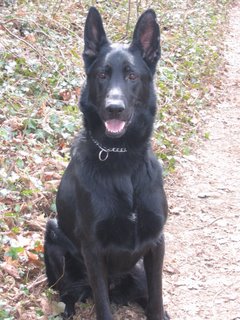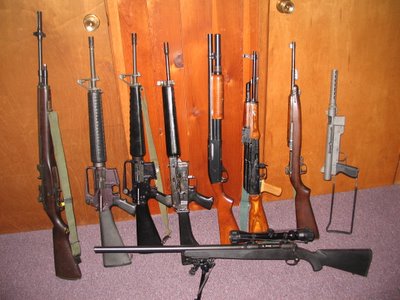I'm the guy on the other side of the computer.
This site is about my life, my travels, my stuff, and Lagniappe, my German Shepherd dog.
I won't post any pictures of me because I'm ugly. I also don't show up on film anyway.
But this is Lagniappe:

Lagniappe is a purebred German Shepherd. Yes, I know you've never seen an all-black German Shepherd before. We hear that every day. But here he is.
His name is pronounced "Lon-Yop". It's Creole French from Louisiana. (NOT that silly girly-French spoken by those cheese-eating surrender-monkeys in Europe.) It means "A little something extra".
Lagniappe lives with me in a nice house in the Blue Ridge Mountains of West Virginia.
We're actually just a short distance from Harpers Ferry. That's this place:

Harpers Ferry is steeped in history. It sits at the conflux of the Shenandoah and Potomac Rivers in what used to be Virginia. A fellow named Robert Harper started a ferry service here in the mid-1700's. In 1799, the second United States arsenal was built here at the insistence of George Washington. Between 1801 and the outbreak of the Civil War in 1861, the Armory produced more than 600,000 muskets, rifles, and pistols, and employed, at times, over 400 workers. On October 16, 1859, it became famous when the arsenal was attacked and briefly captured by radical abolitionist John Brown. Brown--a man I like to call "America's first terrorist"--seized the arsenal and planned to take all the guns in order to arm freed slaves and create a guerilla army. Brown and 21 of his followers did take the armory buildings but Brown was then unpleasantly suprised to find that other abolitionists did not show up to help. Nor did spontaneous slave uprisings take place on local plantations. Brown had expected reinforcements from both quarters and when no one showed up to back him up, he found himself barricaded in the arsenal's engine house by armed townspeople and the local militia. Finally the US Marines showed up, led by a Colonel named Robert E. Lee. A party of Marines broke down the door of the arsenal engine house and subdued Brown and his gang. This party was led into the engine house by another soldier who would soon become famous:Lieutenant JEB Stuart.
Brown was tried in nearby Charles Town and convicted of Insurrection, Treason and Murder. He was sentenced to hang and rushed off to the gallows on December 2nd, 1859.
Present at the hanging was another soon-to-be notable: Professor Thomas Jackson commanded a regiment of cadets from the Virginia Military Academy. They were there to provide security against an expected rescue attempt but no one paid Professor Jackson much mind. They would later, however.
Soon he would be known as Stonewall Jackson and he'd be back as a Confederate General to capture Charles Town and Harpers Ferry.
And still another soon-to-be-famous (or infamous) person was present at the hanging. A well-known actor of the time named John Wilkes Booth had joined the local militia company just so he could witness the hanging. He'd go on to assasinate a US President but on this day he was just another face in the crowd.
Ironically, not two years later, the same militia companies that fought to take the arsenal back from John Brown would march on Harpers Ferry again. Only this time they sought to seize the arsenal themselves on behalf of the secessionist state of Virginia. One of the militia companies trying to seize it was even led by one of Brown's former defense lawyers. But they were a day late and a dollar short as Union forces blew up the armory before making a hasty retreat across the river into Maryland.
Harpers Ferry was also noteworthy as a stopping point on both the C&O Canal and the Baltimore and Ohio Railroad. Both rival transportation systems paralleled the Potomac River and Harpers Ferry was an important stopping-off point for each.
But the war of 1861--also known as the Civil War and the War of Northern Aggression--pretty much deciminated Harpers Ferry. Union and Confederate forces took turns capturing and recapturing it, with one side shelling it as they advanced and the other side burning it as they left. And what the war didn't destroy, periodic floods of the rivers did. Today Harpers Ferry is a shell of what it used to be, and it exists as a tourist destination controlled by the National Park Service. The United States arsenal is gone. But of course there is another. Lagniappe and I oversee this one.




Yep. Lagniappe and I are all set for the next go-round.
A bit more about me. I'm a shooter and collector from way back. I shoot high-power matches and sporting clays. I'm also a pistol competitor.
And yes, that is a machine gun next to Lagniappe. It's an MK Arms model 760 9mm submachine gun. Law-abiding citizens can own those here in West Virginia. Ain't Freedom great?
Happy anniversary! Miss you Lagniappe!
ReplyDelete